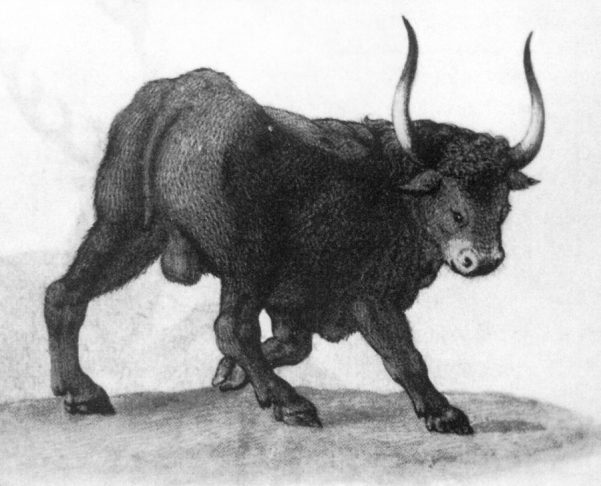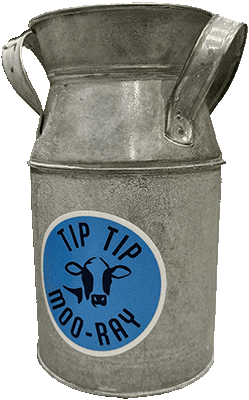Raw milk often comes from cows. But what are cows? Here’s a general overview of some notable cow breeds, their significance, and the time in which they appear.
Cows, chronologically
- Aurochs: The ancestor of modern cattle, domesticated in various regions around the world. Significant as the foundation of all modern cattle breeds. Between 280,000 and 330,000 years before present, the extinct wild auroch (Bos primigenius) population diverged into two distinct genetic strains: the humpless Bos taurus and the humped Bos indicus.
- Zebu (4000 BC): Originated in South Asia. Known for heat tolerance and used for both dairy and beef. Significant in tropical agriculture.
- Brahman (3000 BC): Originated in India, known for their heat tolerance and disease resistance. Significant in tropical regions.
- Chianina (200 BC): Originated in Italy. One of the oldest breeds, known for large size and high-quality beef. Significant in beef production and as draft animals.
- Highland (6th Century): Originated in Scotland. Known for hardiness and distinctive appearance. Significant in beef production and conservation grazing.
- Brown Swiss (7th Century): One of the oldest cattle breeds, originating in Switzerland. Known for high milk and cheese production. Significant in dairy farming.
- Guernsey (10th Century): Originated on the Island of Guernsey. Known for rich, golden milk. Significant in dairy production, especially for butter and cheese.
- Angus (16th Century): Developed in Scotland, known for their high-quality beef. Significant in the beef industry worldwide.
- Galloway (17th Century): Originated in Scotland. Known for hardiness and high-quality beef. Significant in beef production, particularly in harsh climates.
- Hereford (18th Century): Originated in Herefordshire, England. Known for their hardiness and efficient feed conversion. Significant in both beef and dairy industries.
- Holstein-Friesian (18th Century): Originated in the Netherlands and Germany. Known for high milk production. Significant in the dairy industry globally.
- Jersey (18th Century): Originated on the Island of Jersey. Known for high butterfat content in milk. Significant in dairy production, especially for cheese and butter.
- Ayrshire (18th Century): Originated in Scotland. Known for efficient conversion of forage to milk. Significant in dairy farming, particularly in grass-based systems.
- Dexter (18th Century): Originated in Ireland. Known for small size and dual-purpose use (milk and beef). Significant in small-scale farming and homesteads.
- Shorthorn (18th Century): Developed in northeastern England. Known for both beef and dairy qualities. Significant in dual-purpose farming.
- Texas Longhorn (19th Century): Originated in the United States. Known for distinctive long horns and lean beef. Significant in beef production and cultural heritage.
- Montbéliarde (19th Century): Originated in France. Known for both milk and beef production. Significant in dual-purpose farming.
- Simmental (19th Century): Originated in Switzerland. Known for both milk and beef production. Significant in dual-purpose farming and adaptability to various climates.
- Charolais (19th Century): Originated in France. Known for rapid growth and lean beef. Significant in the beef industry for crossbreeding.
- Limousin (19th Century): Originated in France. Known for lean beef and efficient feed conversion. Significant in the beef industry.
- Nelore (20th Century): Originated in Brazil from Indian Ongole cattle. Known for heat tolerance and beef production. Significant in tropical beef production.
- Belted Galloway (20th Century): Originated in Scotland. Known for their distinctive belted pattern and hardiness. Significant in niche beef markets.
- Red Angus (20th Century): A variant of Angus cattle, known for similar beef qualities. Significant in the beef industry.
- Wagyu (20th Century): Originated in Japan. Known for highly marbled beef. Significant in high-end beef markets.
Notes

The logo on this website is an Aurochs, the first cow, before cows were cows. It’s stamp art of an Aurochs, derived from a 16th century illustration made just decades before they went extinct in the 17th century.
Jersey trad… compared to what?
Jersey cows and Holsteins appear in the same century. This disproves the common belief that Jersey cows are more “authentic” than Holstein cows.
While the modern feed-lot Holstein has likely experienced further selective effects toward capitalistic ends, and appears to produce A1 structured casein most commonly, these cows are not newer than the Jersey which usually produces A2 protein. Around the same time, Holsteins cows were selected for volume and Jersey cows were selected for butterfat content. Jersey cows just somehow retained the A2 on its own trajectory.
Waygu the last non-bioengineered breed?
Not-so-surprised that the fatty Waygu cattle are very new.
Japanese farmers produced the first Waygu cow in 1944, which made its way to America in 1975. Extremely fatty Waygu cuts have made the rounds on social media, but most Waygu beef is slightly-fattier-than-usual. The largest US Waygu producer is Snake River Farms, an Agri Beef company based in Idaho. I haven’t found any raw Waygu milk, but that would be a rare find.




